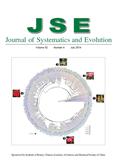Yun-Rui MAO, Yong-Hua ZHANG, Koh NAKAMURA, Bi-Cai GUAN, Ying-Xiong QIU
Species of Podophyllum, Dysosma, Sinopodophyllum, and Diphylleia, genera from Podophylloideae of Berberidaceae, have long been used in traditional herbal medicine in East Asia and/or North America. Accurate identification of the species of these four genera is crucial to their medicinal uses. In this study, we tested the utility of nine barcodes (matK, rbcL, atpH-atpI, rpl32-trnLUAG, rps18-clpp, trnL-trnF, trnL-ndhJ, trnS-trnfM, and internal transcribed spacer (ITS)) to discriminate different species of Podophylloideae. Thirty-six individuals representing 12 species of Podophylloideae were collected from different locations in China, Japan, and North America. We assessed the feasibility of amplification and sequencing of all markers, examined the levels of the barcoding gap based on DNA sequence divergence between ranges of intra- and interspecific variation using pairwise distances, and further evaluated successful identifications using each barcode by similarity-based and tree-based methods. Results showed that nine barcodes, except rps18-clpp, have a high level of primer universality and sequencing success. As a single barcode, ITS has the most variable sites, greater intra- and interspecific divergences, and the highest species discrimination rate (83%), followed by matKwhich has moderate variation and also high species discrimination rates. However, these species can also be discriminated by ITS alone, except Dysosma versipellis (Hance) M. Cheng ex T. S. Ying and D. pleiantha (Hance) Woodson. The combination of ITS + matK did not improve species resolution over ITS alone. Thus, we propose that ITS may be used as a sole region for identification of most species in Podophylloideae. The failure of ITS to distinguish D. versipellis and D. pleiantha is likely attributed to incomplete lineage sorting due to recent divergence of the two species.

